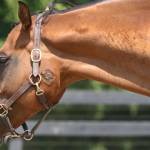Immunotherapy Improves Recovery Odds of Horses with Sarcoids

Sarcoids are often aesthetically displeasing but, more importantly, they may cause discomfort and performance limitations depending on where they form. With no effective treatment available for these common neoplasms, a recently developed technique called “sarcoid immunotherapy” could be the solution.
Sarcoids are locally aggressive, nonmetastatic growths caused by certain bovine papillomaviruses (BPV). Potential treatments include surgical excision, cryotherapy, and chemotherapy, either alone or in combination. Many of these treatments, however, seem to be counterproductive. According to a recent report, those treatments may lead to recurrence in a substantial number of cases.* When those growths recur, they tend to be more aggressive than the original lesions.
“Despite the poor prognosis associated with therapy, sarcoids can grow in anatomic locations that limit the function of the horse—the saddle region, for example. This often demands that veterinarians ‘try anything,’ often with unfortunate consequences,” said Catherine Whitehouse, M.S., a Kentucky Equine Research nutritionist.
A novel approach to treating sarcoids currently being explored involves administration of “immunotherapeutic vaccines.” The rationale for immunotherapy is simple: spur the horse’s immune system into action, prompting it to destroy sarcoid tumor cells. The vaccines were created using preexisting technology that involved inserting specific BPV genes into influenza virus particles that invade sarcoid cells.
Two distinct therapeutic vaccines were created and subsequently tested in 29 horses classified with mild, moderate, and severe sarcoma. Treatment resulted in sarcoid regression in 20 of the 29 patients, and regression occurred over the course of many months, anywhere from six to 20. Of the nine horses that did not respond, all had severe disease and five had a history of previous unsuccessful treatment.
“Another important finding was that synchronous tumor regression was observed. This means that both injected and noninjected lesions responded to treatment,” shared Whitehouse.
This therapeutic approach brings light to a bleak situation; however, additional work must be performed to optimize the immunotherapeutic agent and devise effective treatment schedules. Nonetheless, the researchers noted, “The strategy has already proven effective in reducing or eliminating the sarcoid burden even in severe cases, and in clearing the BPV infection that underlies disease development.”
Support skin health by feeding a well-fortified diet. Targeted supplementation with well-known immune boosters may be warranted in special cases. The antioxidant vitamin E is known to modulate immune function, so supplemental vitamin E may be appropriate for horses with sarcoids. “Studies conducted at Kentucky Equine Research indicate that Nano-E, which features a delivery system known as nanodispersion, is the most rapidly absorbable form of vitamin E when compared to synthetic and other natural sources,” explained Whitehouse.
*Jindra, C., E.K. Hainisch, A. Rümmele, M. Wolscek, T. Muster, and S. Brandt. 2021. Influenza virus vector iNS1 expressing bovine papillomavirus 1 (BPV1) antigens efficiently induces tumour regression in equine sarcoid patients. PLoS One 16(11):e0260155.








